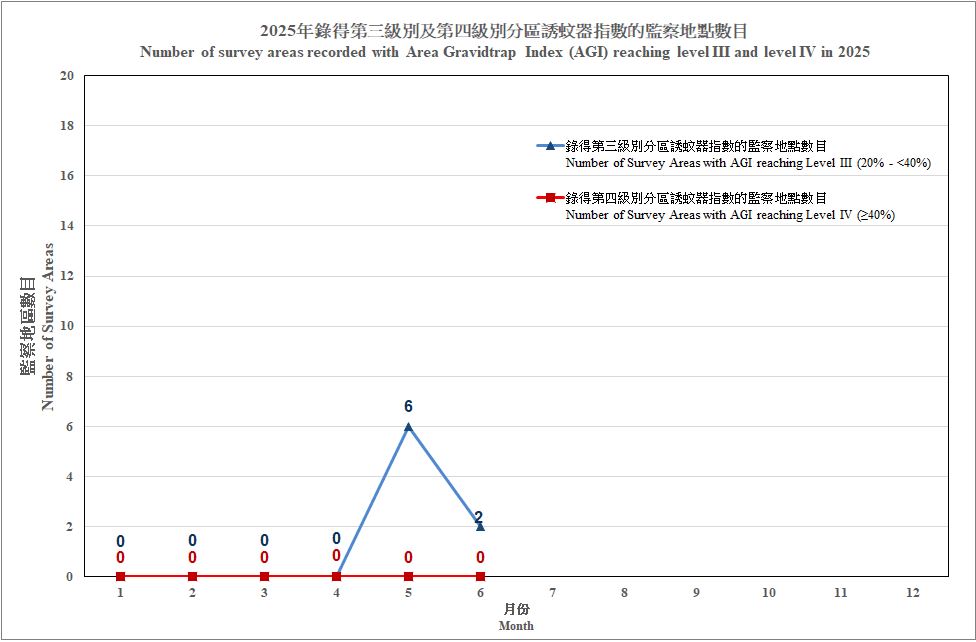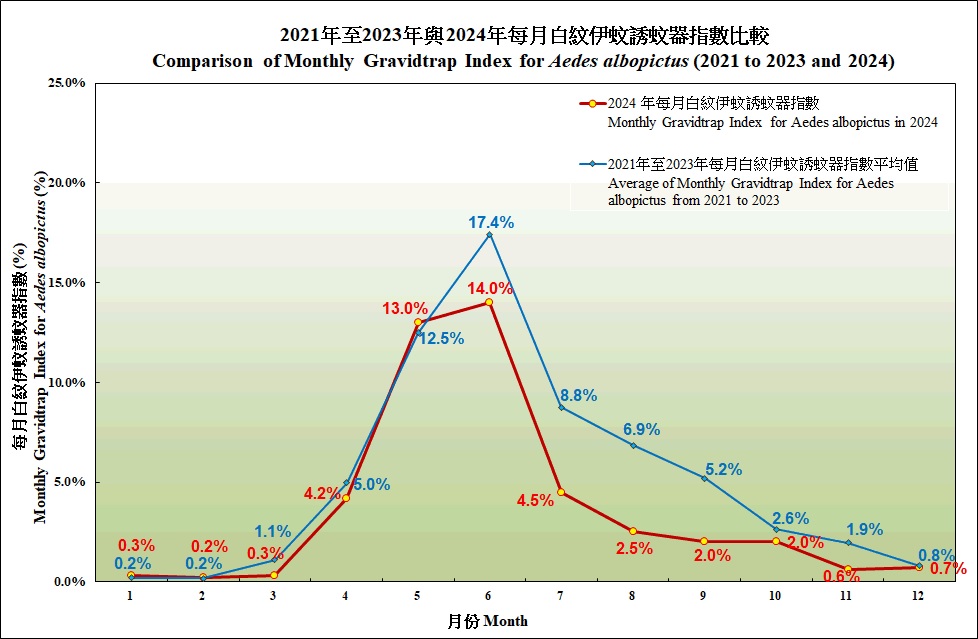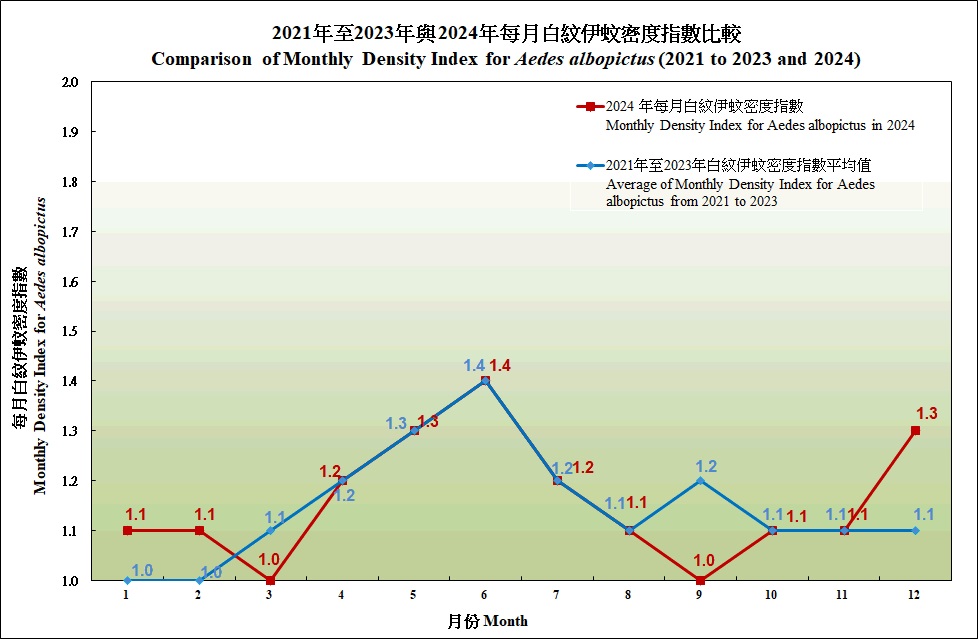At present, there are a total of 64 survey areas selected for the vector surveillance throughout the territory and the following four different indices will be enumerated:
- Area Gravidtrap Index for Aedes albopictus (AGI),
- Area Density Index for Aedes albopictus (ADI),
- Monthly Gravidtrap Index for Aedes albopictus (MGI), and
- Monthly Density Index for Aedes albopictus (MDI).
Please click here for details of Gravidtrap survey methodology
Brief of Gravidtrap Indices and Density Indices in June 2024
|
The Monthly Gravidtrap Index for Aedes albopictus mosquitoes in June 2024 was 14 per cent, at Level 2, indicating that the distribution of Aedes albopictus mosquitoes in the areas surveyed was fairly extensive. In June, among the 64 survey areas, the Area Gravidtrap Index in eight areas exceeded the alert level of 20 per cent. Moreover, the Monthly Density Index for Aedes albopictus in June was 1.4, which represented that an average of 1.4 Aedes albopictus adults were found in the Aedes-positive Gravidtraps, indicating that the number of adult Aedes albopictus was not abundant in the survey areas. |
The phased Gravidtrap Indices and Density Indices for Aedes albopictus for each surveyed area in July 2024 are provided below:
| Hong Kong Island | |||||
|---|---|---|---|---|---|
|
District |
Survey area |
First Phase Gravidtrap Index | First Phase Density Index | Area Gravidtrap Index | Area Density Index |
| Central/ Western | Central and Admiralty | 1.9% | 3.0 | 2.9% | 1.7 |
| Sheung Wan and Sai Ying Pun | 5.4% | 1.0 | |||
| Sai Wan | 3.7% | 1.5 | |||
| Eastern | Chai Wan West | 1.8% | 1.0 | 4.5% | 1.0 |
| Shau Kei Wan and Sai Wan Ho | 1.9% | 1.0 | 2.9% | 1.0 | |
| North Point | 11.1% | 1.0 | 5.5% | 1.0 | |
| Southern | Aberdeen and Ap Lei Chau | 9.4% | 1.0 | 8.5% | 1.2 |
| Pokfulam | 3.5% | 1.0 | 2.6% | 1.0 | |
| Deep Water Bay and Repulse Bay | 1.7% | 1.0 | |||
| Wan Chai | Tin Hau | 9.1% | 1.2 | 8.4% | 1.8 |
| Wan Chai North | 1.9% | 1.0 | 0.9% | 1.0 | |
| Happy Valley | 3.7% | 1.0 | 2.8% | 1.0 | |
| Islands | |||||
| Islands | Cheung Chau South | 0.0% | N/A | ||
| Cheung Chau North | 2.9% | 1.0 | |||
| Tung Chung | 0.0% | N/A | |||
| Kowloon | |||||
|---|---|---|---|---|---|
| District | Survey area | First Phase Gravidtrap Index | First Phase Density Index | Area Gravidtrap Index | Area Density Index |
| Yau Tsim | Tsim Sha Tsui | 6.3% | 1.3 | 4.7% | 1.2 |
| Tsim Sha Tsui East | 3.8% | 1.0 | 3.8% | 1.0 | |
| Mong Kok | Mong Kok | 5.0% | 1.0 | 2.5% | 1.0 |
| Sham Shui Po | Cheung Sha Wan | 3.6% | 1.0 | ||
| Lai Chi Kok | 1.8% | 1.0 | |||
| Sham Shui Po East | 3.7% | 1.0 | |||
| Kowloon City | Ho Man Tin | 1.9% | 1.0 | 1.9% | 1.0 |
| Kowloon City North | 0.0% | N/A | |||
| Hung Hom | 0.0% | N/A | |||
| Lok Fu West | 5.2% | 2.0 | |||
| Kai Tak North | 11.1% | 1.0 | |||
| Wong Tai Sin | Wong Tai Sin Central | 11.3% | 1.0 | 8.4% | 1.0 |
| Wong Tai Sin West | 9.3% | 1.2 | 7.4% | 1.4 | |
| Diamond Hill | 6.9% | 1.0 | 4.5% | 1.0 | |
| Ngau Chi Wan | 13.2% | 1.3 | 7.5% | 1.3 | |
| Kwun Tong | Kwun Tong Central | 15.6% | 1.3 | ||
| Lam Tin | 5.0% | 1.0 | |||
| Yau Tong | 0.0% | N/A | |||
| Kowloon Bay | 1.6% | 1.0 | |||
| New Territories | |||||
|---|---|---|---|---|---|
| District | Survey area | First Phase Gravidtrap Index | First Phase Density Index | Area Gravidtrap Index | Area Density Index |
| Sai Kung | Tseung Kwan O West | 3.6% | 1.0 | ||
| Tseung Kwan O East | 3.8% | 1.0 | |||
| Tseung Kwan O North | 16.3% | 1.3 | |||
| Sai Kung Town | 1.9% | 1.0 | |||
| Ngau Liu and Muk Min Shan | 0.0% | N/A | |||
| Sha Tin | Tai Wai | 7.0% | 1.0 | 7.6% | 1.1 |
| Sha Tin East | 6.3% | 1.0 | 4.8% | 1.0 | |
| Ma On Shan | 21.9% | 1.1 | 12.7% | 1.1 | |
| Sha Tin Town Centre and Fo Tan |
7.3% |
1.0 | 5.5% | 1.0 | |
| Tai Po | Tai Po West | 1.7% | 1.0 | ||
| Tai Po East | 1.9% | 1.0 | 1.9% | 1.0 | |
| North | Fanling | 1.8% | 1.0 | ||
| Sheung Shui | 11.5% | 1.3 | 13.0% | 1.2 | |
| Yuen Long | Tin Shui Wai | 11.1% | 1.0 | 7.1% | 1.0 |
| Yuen Kong | 0.0% | N/A | |||
| Yuen Long Town | 4.0% | 1.5 | 2.9% | 1.3 | |
| Ki Lun Shan | 0.0% | N/A | |||
| Sung Shan | 4.2% | 1.0 | |||
| Tuen Mun | Tuen Mun North | 0.0% | N/A | 0.8% | 1.0 |
| Tuen Mun South | 5.5% | 1.0 | |||
| Tuen Mun West | 4.3% | 1.5 | 2.1% | 1.5 | |
| So Kwun Wat | 1.7% | 1.0 | 1.7% | 1.0 | |
| Tseun Wan | Tsuen Wan Town | 7.0% | 1.3 | ||
| Tsuen Wan West | 2.0% | 1.0 | |||
| Ma Wan | 4.0% | 1.0 | |||
| Sheung Kwai Chung | 0.0% | N/A | |||
| Kwai Tsing | Kwai Chung | 6.8% | 1.0 | 4.2% | 1.0 |
| Lai King | 3.8% | 1.0 | |||
| Tsing Yi South | 0.0% | N/A | |||
| Tsing Yi North | 3.8% | 1.5 | |||
Index value remarks:
| Colour | Gravidtrap Index | Density Index |
| Green:Level I | Gravidtrap Index < 5.0% [indicates that the distribution of Aedes albopictus is not extensive] | 1.0 ≤ Density Index ≤ 1.5 [Aedes albopictus is not abundant in the locations with positive Gravidtraps] |
| Yellow:Level II | 5.0% ≤ Gravidtrap Index < 20.0% [indicates that the distribution of Aedes albopictus is fairly extensive] | 1.6 ≤ Density Index ≤ 2.4 [Aedes albopictus is slightly abundant in the locations with positive Gravidtraps] |
| Red:Level III | 20.0% ≤ Gravidtrap Index < 40.0% [indicates that the distribution of Aedes albopictus is extensive] |
Density Index ≥ 2.5 [Aedes albopictus is abundant in the locations with positive Gravidtraps] |
| Purple:Level IV | Gravidtrap Index ≥ 40.0% [indicates that the distribution of Aedes albopictus is very extensive] |
Number of areas in respective levels of Survey Area Gravidtrap Indices in 2024 are provided below:
| Number of survey areas recorded with respective Index Level | Total number of survey areas | Top 5 survey areas at level 3 | Top 5 survey areas at level 4 | ||||
|---|---|---|---|---|---|---|---|
| Level 1 | Level 2 | Level 3 | Level 4 | ||||
| 0%-<5% | 5%-<20% | 20%-<40% | ≥40% | ||||
| Jan | 64 | 0 | 0 | 0 | 64 | Nil | Nil |
| Feb | 63 | 1 | 0 | 0 | 64 | Nil | Nil |
| Mar | 64 | 0 | 0 | 0 | 64 | Nil | Nil |
| Apr | 46 | 17 | 1 | 0 | 64 | 1. Hung Hom | Nil |
| May | 4 | 50 | 9 | 1 | 64 | 1. Sai Kung Town 2. Tsuen Wan West 3. Sheung Kwai Chung 4. Yau Tong 5. So Kwun Wat |
1. Sheung Shui |
| Jun | 5 | 51 | 7 | 1 | 64 | 1. So Kwun Wat 2. Ma On Shan 3. Ngau Chi Wan 4. Yau Tong 5. Tseung Kwan O North |
1. Sheung Shui |
Number of survey areas recorded with Area Gravidtrap Index reaching level III and Level IV in 2024 is provided below:

Please click here for annual hotspot map on survey locations with Area Gravidtrap Index (AGI) reaching Level III and Level IV.
Comparison of Monthly Gravidtrap Index and Monthly Density Index for Aedes albopictus (2021 to 2023 and 2024) are provided below:


Please click here for Record of Indices in 2024.
Information of Major Port Areas
The Port Monthly Gravidtrap Index and the Port Monthly Density Index for Aedes albopictus for June 2024 are 3.8% and 1.3 respectively.
Port Gravidtrap Indices and Port Density Indices for Aedes albopictus in 2024 are provided below:
| Port areas (Map) | |||||||||||||
|---|---|---|---|---|---|---|---|---|---|---|---|---|---|
| Port Area | Jan | Feb | Mar | Apr | May | Jun | Jul | Aug | Sep | Oct | Nov | Dec | |
| Hong Kong International Airport | PGI | 0.0% | 0.0% | 0.0% | 0.3% | 1.1% | 1.0% | ||||||
| PDI | N/A | N/A | N/A | 1.1 | 1.2 | 1.2 | |||||||
| Cross Boundary Check Points on Land | PGI | 0.4% | 0.0% | 0.3% | 5.2% | 10.6% | 7.7% | ||||||
| PDI | 1.0 | N/A | 1.0 | 1.4 | 1.4 | 1.4 | |||||||
| Private Cargo Working Areas | PGI | 0.3% | 0.0% | 0.6% | 2.9% | 10.1% | 12.0% | ||||||
| PDI | 1.0 | N/A | 1.0 | 1.1 | 1.1 | 1.2 | |||||||
| Cross Boundary Ferry Terminals | PGI | 0.0% | 0.0% | 0.5% | 0.0% | 2.0% | 1.5% | ||||||
| PDI | N/A | N/A | 1.0 | N/A | 1.2 | 1.0 | |||||||
| Container Terminals | PGI | 0.0% | 0.0% | 0.1% | 0.6% | 2.0% | 1.7% | ||||||
| PDI | N/A | N/A | 1.0 | 1.0 | 1.2 | 1.0 | |||||||
| Public Cargo Working Areas | PGI | 0.2% | 0.0% | 0.4% | 2.9% | 12.7% | 10.6% | ||||||
| PDI | 1.0 | N/A | 1.0 | 1.2 | 1.3 | 1.2 | |||||||
Index value remarks:
| Colour | Gravidtrap Index | Density Index |
| Green:Level I | Gravidtrap Index < 5.0% [indicates that the distribution of Aedes albopictus is not extensive] | 1.0 ≤ Density Index ≤ 1.5 [Aedes albopictus is not abundant in the locations with positive Gravidtraps] |
| Yellow:Level II | 5.0% ≤ Gravidtrap Index < 20.0% [indicates that the distribution of Aedes albopictus is fairly extensive] | 1.6 ≤ Density Index ≤ 2.4 [Aedes albopictus is slightly abundant in the locations with positive Gravidtraps] |
| Red:Level III | 20.0% ≤ Gravidtrap Index < 40.0% [indicates that the distribution of Aedes albopictus is extensive] |
Density Index ≥ 2.5 [Aedes albopictus is abundant in the locations with positive Gravidtraps] |
| Purple:Level IV | Gravidtrap Index ≥ 40.0% [indicates that the distribution of Aedes albopictus is very extensive] |
Historical information in respect of Ovitrap indices, Gravidtrap Indices and Density Indices
Please click here for the Monthly Ovitrap Index, Gravidtrap Index and Density Index for Aedes albopictus from 2013 to 2023.
Please click here for a graph of comparison of Monthly Ovitrap Index for Aedes albopictus: 2010 to 2019 and 2020.
Please click here for a graph of comparison of Monthly Gravidtrap Index for Aedes albopictus: 2020 to 2022 and 2023.
Please click here for a graph of comparison of Monthly Density Index for Aedes albopictus: 2020 to 2022 and 2023.
Please click here for the Port Monthly Ovitrap Index, Gravidtrap Index and Density Index for Aedes albopictus from 2013 to 2023.